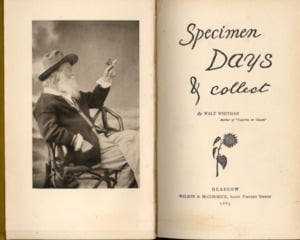
Ouster’s Last Rally Walt Whitman
На этой странице вы найдете полный текст песни "Ouster’s Last Rally" от Walt Whitman. Lyrxo предлагает вам самый полный и точный текст этой композиции без лишних отвлекающих факторов. Узнайте все куплеты и припев, чтобы лучше понять любимую песню и насладиться ею в полной мере. Идеально для фанатов и всех, кто ценит качественную музыку.

Went to-day to see this just-finish'd painting by John Mulvany, who has been out in far Dakota, on the spot, at the forts, and among the frontiersmen, soldiers and Indians, for the last two years, on purpose to sketch it in from reality, or the best that could be got of it. Sat for over an hour before the picture, completely absorb'd in the first view. A vast canvas, I should say twenty or twenty-two feet by twelve, all crowded, and yet not crowded, conveying such a vivid play of color, it takes a little time to get used to it. There are no tricks; there is no throwing of shades in masses; it is all at first painfully real, overwhelming, needs good nerves to look at it. Forty or fifty figures, perhaps more, in full finish and detail in the mid-ground, with three times that number, or more, through the rest—swarms upon swarms of savage Sioux, in their war-bonnets, frantic, mostly on ponies, driving through the background, through the smoke, like a hurricane of demons. A dozen of the figures are wonderful. Altogether a western, autochthonic phase of America, the frontiers, culminating, typical, deadly, heroic to the uttermost—nothing in the books like it, nothing in Homer, nothing in Shakspere; more grim and sublime than either, all native, all our own, and all a fact. A great lot of muscular, tan-faced men, brought to bay under terrible circumstances—death ahold of them, yet every man undaunted, not one losing his head, wringing out every cent of the pay before they sell their lives. Custer (his hair cut short stands in the middle), with dilated eye and extended arm, aiming a huge cavalry pistol. Captain Cook is there, partially wounded, blood on the white handkerchief around his head, aiming his carbine coolly, half kneeling—(his body was afterwards found close by Custer's.) The slaughter'd or half-slaughter'd horses, for breastworks, make a peculiar feature. Two dead Indians, herculean, lie in the foreground, clutching their Winchester rifles, very characteristic. The many soldiers, their faces and attitudes, the carbines, the broad-brimm'd western hats, the powder-smoke in puffs, the dying horses with their rolling eyes almost human in their agony, the clouds of war-bonneted Sioux in the background, the figures of Custer and Cook—with indeed the whole scene, dreadful, yet with an attraction and beauty that will remain in my memory. With all its color and fierce action, a certain Greek continence pervades it. A sunny sky and clear light envelop all. There is an almost entire absence of the stock traits of European war pictures. The physiognomy of the work is realistic and Western. I only saw it for an hour or so; but it needs to be seen many times—needs to be studied over and over again. I could look on such a work at brief intervals all my life without tiring; it is very tonic to me; then it has an ethic purpose below all, as all great art must have. The artist said the sending of the picture abroad, probably to London, had been talk'd of. I advised him if it went abroad to take it to Paris. I think they might appreciate it there—nay, they certainly would. Then I would like to show Messieur Crapeau that some things can be done in America as well as others.
Комментарии (0)
Минимальная длина комментария — 50 символов.












